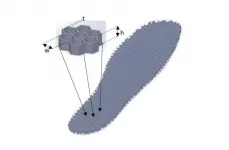(Press-News.org) As many as 450,000 Americans die every year from a sudden, fatal heart condition, and in slightly more than one in ten cases the cause remains unexplained even after an autopsy. Researchers from the University of Maryland School of Medicine (UMSOM) and their colleagues found that nearly 20 percent of patients with unexplained sudden cardiac death - most of whom were under age 50 - carried rare genetic variants. These variants likely raised their risk of sudden cardiac death. In some cases, their deaths may have been prevented if their doctors had known about their genetic predisposition to heart disease. The study findings were published last week in JAMA Cardiology.
"Genetic screening isn't routinely used in cardiology, and far too many patients still die suddenly from a heart condition without having any previously established risk factors. We need to do more for them," said study corresponding author Aloke Finn, MD, Clinical Associate Professor of Medicine at UMSOM.
To conduct the study, Dr. Finn and his colleagues performed genetic sequencing in 413 patients, who died at age 41 on average of sudden unexplained heart failure. Nearly two-thirds of the group were men, and about half were African American. The study found that 18 percent of patients who experienced sudden death had previously undetected genes associated with life-threatening arrhythmia or heart failure conditions. None of those who carried these genetic variants had been previously diagnosed with these abnormalities. Their hearts looked normal on autopsies without any signs of heart failure or significant blockages in their coronary arteries.
"What we found opens the door and asks some important questions," said Dr. Finn. "Should we be doing routine genetic screening in those who have a family history of unexplained sudden cardiac death?"
Such screening could have the potential to save lives. It may also leave patients and doctors in a quandary over what to do with such information. There are currently no clear guidelines on how to monitor or treat patients with these variants in the absence of clinically detectable disease.
Study faculty co-authors from UMSOM include Kristen Maloney, MS, Instructor of Medicine, Libin Wang, BM PhD, Assistant Professor of Medicine, Susie Hong, MD, Assistant Professor of Medicine, Anuj Gupta, MD, Associate Professor of Medicine, Linda Jeng, MD, PhD, Clinical Associate Professor of Medicine, Braxton Mitchell, PhD, Professor of Medicine, and Charles Hong, MD, PhD, the Melvin Sharoky, MD, Professor of Medicine.
"This is a fascinating study that provides important new insights into devastating deaths due to unexplained cardiac abnormalities," said E. Albert Reece, MD, PhD, MBA, Executive Vice President for Medical Affairs, UM Baltimore, and the John Z. and Akiko K. Bowers Distinguished Professor and Dean, University of Maryland School of Medicine. "It certainly makes the case for more research to address this urgent health need and save lives in the future."
INFORMATION:
About the University of Maryland School of Medicine
Now in its third century, the University of Maryland School of Medicine was chartered in 1807 as the first public medical school in the United States. It continues today as one of the fastest growing, top-tier biomedical research enterprises in the world -- with 45 academic departments, centers, institutes, and programs; and a faculty of more than 3,000 physicians, scientists, and allied health professionals, including members of the National Academy of Medicine and the National Academy of Sciences, and a distinguished two-time winner of the Albert E. Lasker Award in Medical Research. With an operating budget of more than $1.2 billion, the School of Medicine works closely in partnership with the University of Maryland Medical Center and Medical System to provide research-intensive, academic and clinically based care for nearly 2 million patients each year. The School of Medicine has more than $563 million in extramural funding, with most of its academic departments highly ranked among all medical schools in the nation in research funding. As one of the seven professional schools that make up the University of Maryland, Baltimore campus, the School of Medicine has a total population of nearly 9,000 faculty and staff, including 2,500 student trainees, residents, and fellows. The combined School of Medicine and Medical System ("University of Maryland Medicine") has an annual budget of nearly $6 billion and an economic impact more than $15 billion on the state and local community. The School of Medicine, which ranks as the 8th highest among public medical schools in research productivity, is an innovator in translational medicine, with 600 active patents and 24 start-up companies. The School of Medicine works locally, nationally, and globally, with research and treatment facilities in 36 countries around the world. Visit medschool.umaryland.edu
WASHINGTON--After their initial blast, space rockets shoot away from the Earth with rumbles in infrasound, soundwaves too low to be heard by human ears that can travel thousands of miles.
New research used a system for monitoring nuclear tests to track the infrasound from 1,001 rocket launches. The research identified the distinctive sounds from seven different types of rockets, including the Space Shuttles, Falcon 9 rockets, various Soyuz rockets, the European Space Agency's Ariane 5, Russian Protons and several types of Chinese Long March rockets.
In some cases, like the Space Shuttle and the Falcon 9, the researchers were also able to identify the various stages of the rockets' journey.
https://youtu.be/IfMtEcNkkho
The ...
Smokers needed their blocked arteries fixed nearly a decade earlier than non-smokers, and patients with obesity underwent these procedures four years earlier than non-obese patients, according to a new statewide study.
The research included patients without a history of heart attack who were treated at hospitals across Michigan participating in BMC2, the Blue Cross Blue Shield of Michigan Cardiovascular Consortium. The patients had undergone angioplasty and/or stenting to widen or unblock their coronary arteries and restore blood flow. Almost all of them had at least one traditional ...
Millions of people with diabetes are at risk of developing foot ulcers, which often lead to amputations and other health complications. Now, Scientists from the Centre for Biomechanics and Rehabilitation Technologies (CRBT) have developed a new method to reliably detect this risk without the need for complex electronic in-shoe sensors.
Dr Panagiotis Chatzistergos, Associate Professor in Orthopaedic Biomechanics, explained: "In the UK alone, 169 people have a toe, foot or limb amputated as a result of diabetes every week, yet importantly up to 80% of these amputations could have been prevented with correct management.
"Routine overloading ...
New research shows what is often assumed to be 'fair' in conservation practice may not be considered so by the very people most affected by it--and a new approach is needed if protected areas are to be effective.
Lead author Dr Georgina Gurney, from the ARC Centre of Excellence for Coral Reef Studies based at James Cook University, said considering local stakeholder conceptions of fairness in conservation is critical.
"If conservation is perceived as unfair it can lead to conflict, undermining support and cooperation," Dr Gurney said.
She said it is not only an ethical matter but key to achieving good ...
University of Illinois Chicago researchers studying birth outcomes in marmoset monkeys found there were no adult maternal characteristics like age or weight gain during pregnancy to predict stillbirth or early neonatal death, but that a mother's birth weight or litter size were associated with early neonatal death.
"Our findings of early life contributions to adult pregnancy outcomes in the common marmoset disrupt mother-blaming narratives of pregnancy outcomes in humans," the paper states.
Julienne Rutherford, associate professor at UIC's School of Nursing, is lead author of "Womb to Womb: Maternal litter size and birth weight but not adult characteristics predict early neonatal death of offspring in the common marmoset monkey" published in the journal PLOS ONE.
Marmosets ...
Since the early days of the COVID-19 pandemic, there were questions about how people in active cancer treatment would fare if they became infected with SARS-CoV-2. The worries were due, in large part, to the effects that cancer and its treatments can have on the immune system. Now that COVID-19 vaccines are widely available, concerns have shifted to the safety and effectiveness of vaccination in this potentially vulnerable population. A study published June 5 in the journal Cancer Cell aims to allay those fears.
In a review of 200 patients with a wide spectrum of cancer diagnoses, researchers at Montefiore Health System and Albert Einstein College of Medicine in the Bronx, NY, found that after full vaccination, 94% of patients overall demonstrated seroconversion, ...
The routes and schedules of public transit, the presence or absence of sidewalks, the availability of different transportation options, and the design of highways that divide cities--these are examples of aspects of transportation systems that can profoundly impact underserved communities' access to basic needs like jobs, health care, education and even food.
A new study by University of Michigan researchers reveals common barriers that transportation decision-makers face in considering these issues and addressing them.
To conduct the study, a team from a multidisciplinary project involving engineering, ...
DARIEN, IL - A study shows that a deep neural network model can accurately predict the brain age of healthy patients based on electroencephalogram data recorded during an overnight sleep study, and EEG-predicted brain age indices display unique characteristics within populations with different diseases.
The study found that the model predicted age with a mean absolute error of only 4.6 years. There was a statistically significant relationship between the Absolute Brain Age Index and: epilepsy and seizure disorders, stroke, elevated markers of sleep-disordered breathing (i.e., apnea-hypopnea index and arousal ...
The widely studied metallic asteroid known as 16 Psyche was long thought to be the exposed iron core of a small planet that failed to form during the earliest days of the solar system. But new University of Arizona-led research suggests that the asteroid might not be as metallic or dense as once thought, and hints at a much different origin story.
Scientists are interested in 16 Psyche because if its presumed origins are true, it would provide an opportunity to study an exposed planetary core up close. NASA is scheduled to launch its Psyche mission in 2022 and arrive at the asteroid in 2026.
UArizona ...
[RALEIGH, N.C.] - How are the squirrels doing this year? The bears? The armadillos? How would you know? A new paper published June 8 sets up the framework for answering these questions across the United States by releasing the data from the first national mammal survey made up of 1,509 motion-activated camera traps from 110 sites located across all 50 states.
Unlike birds, which have multiple large-scale monitoring programs, there has been no standard way to monitor mammal populations at a national scale. To address this challenge, scientists from the North Carolina Museum of Natural Sciences and the Smithsonian Conservation Biology Institute recently collaborated ...


